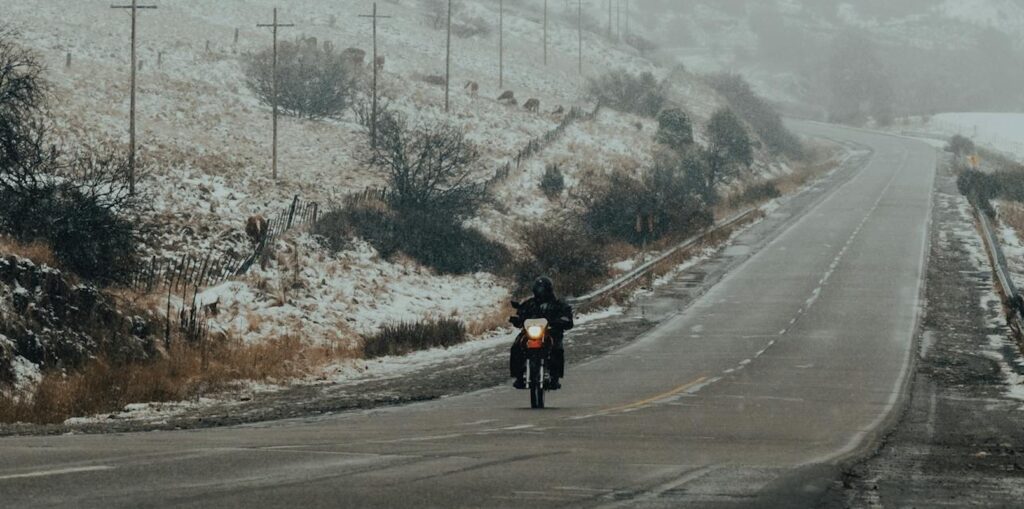
Winter brings unique challenges for motorcyclists. While some riders park their bikes until spring, others embrace the cold months and keep riding. If you’re in the latter group, understanding how to handle the differences winter brings to motorcycle riding is essential. Cold weather affects both your bike and your body, but with proper preparation, you can enjoy safe rides all season.
Table of Contents
How Winter Motorcycle Riding Is Different
Winter weather dramatically changes how motorcycles handle. Factors like cold air, snow, ice, and reduced visibility can impact your safety. Understanding these challenges can help you prepare:
- Cold Air and Wind Chill: Riding at highway speeds in winter can cause body heat to drop rapidly. Without proper insulation, you risk hypothermia and frostbite.
- Reduced Tire Grip: Cold temperatures cause tire rubber to harden, reducing traction. Worn tread further decreases grip, leading to longer stopping distances.
- Unpredictable Road Conditions: Snow, ice, and slush reduce traction and visibility. Even if the forecast looks clear, winter weather can change unexpectedly.
- Decreased Dexterity: Cold affects your body, making your fingers and toes less responsive. This can slow reaction times and reduce control over the throttle, brakes, and other bike functions.
To address these risks, you need the right gear and riding techniques tailored for winter conditions.
Essential Winter Riding Gear
Staying warm and visible is key to riding safely in cold weather. Proper gear ensures you can focus on the road instead of the temperature.
- Layer Up: Start with a moisture-wicking base layer to keep sweat away from your skin. Add an insulating middle layer and a waterproof, windproof outer shell.
- Waterproof Gear: Unexpected snow or rain can make riding miserable if your gear isn’t waterproof. Invest in jackets, pants, and gloves designed to repel moisture.
- Full-Face Helmet: A full-face helmet provides maximum protection from cold air. Pair it with a neck warmer to seal the gap between your helmet and jacket.
- Heated Accessories: Heated gloves, vests, and handlebar grips are lifesavers for longer rides. These accessories help maintain body warmth without restricting movement.
- Reflective Clothing: Shorter daylight hours mean you’ll likely ride in low-light conditions. Reflective jackets and accessories increase your visibility to other drivers.
Choosing comfort over appearance is crucial in winter. Bulkier gear may not look sleek, but it provides the protection you need.
Winter Riding Techniques
Safe winter riding requires a defensive approach and adjustments to your usual habits.
- Warm Up Tires: Cold tires don’t grip well. Start your ride at a moderate pace to allow them to heat up gradually.
- Increase Following Distance: Braking distances are longer in winter, both for you and other vehicles. Leave extra space to react safely.
- Be Cautious of Blind Spots: Snow, sleet, and low light make it harder for drivers to see you. Stay visible and avoid lingering in blind spots.
- Practice Ice and Snow Skills: If you encounter snow or ice, ride gently and avoid sudden braking or acceleration. Use techniques similar to dirt bike riding to stay in control.
- Stay Calm in Adverse Weather: If conditions worsen, pull over and wait for better weather. It’s safer to delay your ride than risk an accident.
Winter motorcycle riding takes skill and focus. It’s best for experienced riders who are confident handling their bikes in challenging conditions.
Maintaining Your Motorcycle in Winter
Cold weather also affects your motorcycle. Proper maintenance keeps it running safely:
- MotorcCheck Tire Pressure: Tires lose pressure in cold weather. Keep them at the recommended PSI to ensure stability and grip.
- Wash Off Road Salt: Salt used on icy roads can corrode your bike. Rinse it thoroughly after rides to prevent damage.
- Choose the Right Tires: All-weather tires with good tread are a must for winter. Avoid using racing tires or worn-out rubber.
- Store Your Bike Properly: If you’re not riding regularly, prepare your bike for storage. Use a cover, clean it thoroughly, and connect it to a battery tender.
A well-maintained bike is safer and more enjoyable to ride, even in winter’s toughest conditions.
Group Riding in Winter
Riding in a group adds a layer of safety during winter rides. Fellow riders provide assistance in emergencies and increase visibility on the road.
- Ride at Your Pace: Don’t feel pressured to match the speed of more experienced riders. Winter roads can be unforgiving, so prioritize safety over keeping up.
- Use Communication Devices: Helmet communicators make it easy to stay in touch with your group. They let you share road updates, warn of hazards, or call for help if needed.
Group rides can be enjoyable and safe, but clear communication and respect for everyone’s comfort level are essential.
Embrace the Adventure
Winter motorcycle riding has its challenges, but it also offers unique rewards. With fewer bikes on the road, quieter routes, and stunning snowy landscapes, the experience can be exhilarating. Prepare yourself with the right gear, skills, and mindset to stay safe and make the most of the season.
Whether you ride solo or with a group, remember to respect the weather and your limits. Dress warmly, stay alert, and keep your bike in top condition. Winter riding isn’t for everyone, but for those who love the thrill, it’s an adventure worth taking.
Contact Cyclist Law for Legal Support
Even with careful planning, accidents can still happen. If you’ve been injured in a motorcycle or cycling accident, Cyclist Law is here to help.
Our firm focuses on representing motorcyclists and cyclists who have been hurt due to someone else’s negligence. We understand the challenges you face and work tirelessly to help you recover the compensation you deserve.
Don’t face the aftermath of an accident alone. Contact Cyclist Law today for a free consultation. Let us handle your case so you can focus on healing and getting back on the road.
